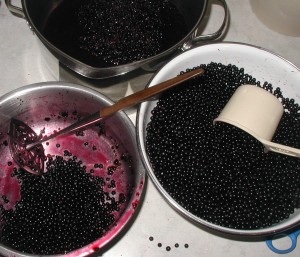A few weeks ago I came across a bookmark for a violet jelly recipe. Last year I marked the recipe page as the violets had already bloomed for the year when I first saw the recipe. I knew that Viola sp. were edible and had already put a few blossoms on top of a salad or on a plate or drink just to snaz things up a bit. The colorful blossoms don’t seem to have much of a taste and that made me curious about violet jelly.
As serendipity would have it, a ton of native violets grow wild on our property. At the time I was reading about making jelly from violets our Northern Downy Violets were in full bloom, so we made a batch of violet jelly! Oddly, I thought it would taste like grapes, because of the cool colors I guess. The real taste is floral – like a violet and slightly fruity or berry-like with a faint hint of elderberry. Elderberry jelly has a much, much stronger flavor, but there were notes of it in our violet jelly.
Three of us went outside on a sunny and breezy day in April to pick two cups of violet flowers. Just the flower heads were needed so any stems that came off the plant were picked out of the bowl. Violet flowers were picked from our backyard on the mountain ridge top.
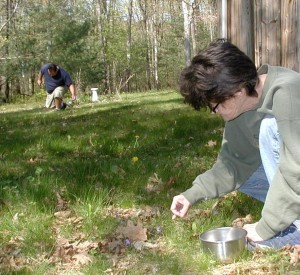
In about 15 minutes time we had the amount of violets we needed to make the jelly. Nearly three cups of violets were loosely tossed into a measuring bowl and the whole amount was firmly packed in a 2-cup glass measuring cup. Now, that’s not firmly packed like brown sugar measured out for a batch of cookies, but the flowers were pressed down lightly to fit in the measuring cup.

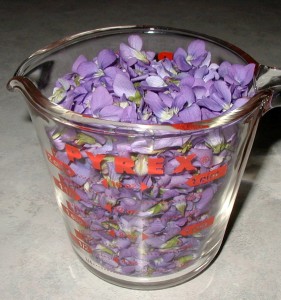
The violets appeared rather clean, but since the pollen has been very high lately they were given a quick rinse with water in a colander anyway.
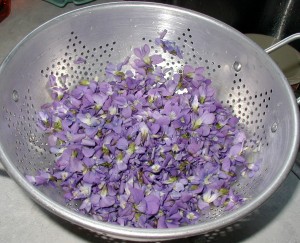
The next step for making the violet jelly was to pour two cups of boiling water on top of the flowers. We want two cups of liquid to make the jelly, so don’t rely on using the measuring cup scale for adding two cups of water. Since the violets already took up space in the measuring cup, boiling water was measured out in a separate measuring cup and then poured on top of the flowers.
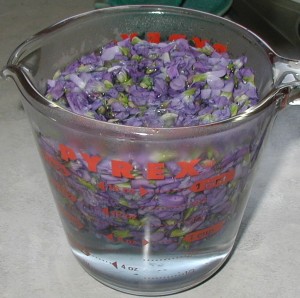
After a couple of hours steeping the deep blue liquid could be decanted off the flowers. We let the measuring cup sit at room temperature for a couple of hours so we could see the color develop and then let it sit in the refrigerator overnight. After 24 hours of total steeping time, a double layer of cheesecloth was draped over a 2 quart bowl and the flower and water mixture was poured over the cheesecloth. The flowers were held back from the liquid and then taken to the compost pile.
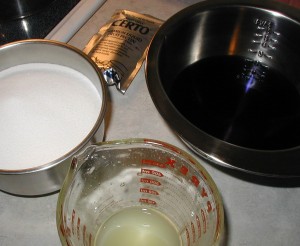
At this point the violet liquid was a very deep blue color. Four cups of sugar were measured out into a separate bowl. A 3 oz. package of liquid pectin, Certo brand, was opened and sat upright in a glass. A quarter cup of lemon juice was measured out too so that all ingredients were ready when needed. Previously, about an hour before, glass jars were washed and sterilized in the dishwasher and the door kept closed so that the jars would stay hot until needed. Bands and lids were sterilized with a kettle of boiling water poured over them as laid out in a skillet and covered with a lid until needed.
Take caution! To cook up the jelly use a 4 quart pan. When we made this particular batch of jelly we used a 2 quart pan to cook the jelly and created one heck of a mess. As the jelly cooks to a boil foam is formed and that foam layer rises a couple of inches up from the liquid level in the pan. Needless to say there was a scorched mess on the stove top to clean up because the hot jelly ran over. I just knew that pan looked a little full at the time, but I neglected my own thoughts and decided to follow the recipe to a T. Wish I had listened to myself, but since I didn’t, maybe you won’t make the same mistake.
At this point in making the jelly we should have transferred the blue liquid to a 4 quart pan before turning on the heat. The heat was set to high and the mixture was constantly stirred. The lemon juice was added and the color changed immediately from deep blue to a light lavender or pink color.
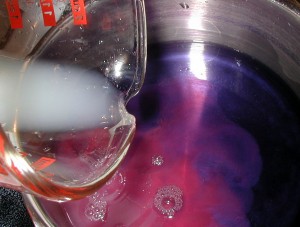
Sugar was added to the pan and the heating continued. It didn’t take too long to bring the mixture to a boil and it was constantly stirred.
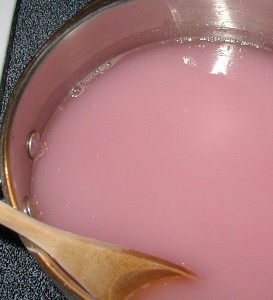
Once the boil was reached, the packet of liquid pectin was added and the mixture boiled for two minutes more. With the smaller pan we had to guess at how long the pectin-sugar-juice mixture was actually boiled because the pan was taken off the heat to stop the boiling over. We guessed ok because the jelly gelled just fine.
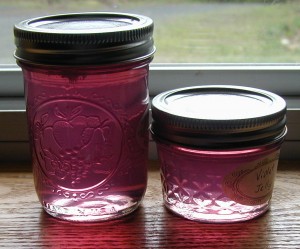
Evidently, the same jelly recipe could be used for other floral jellies, like rose or rose hips jelly, or herb jellies, like mint or lemon thyme jelly. It would be fun to try some other fine jellies like that, but if we find another big violet patch, we’ll be making some more violet jelly first.
